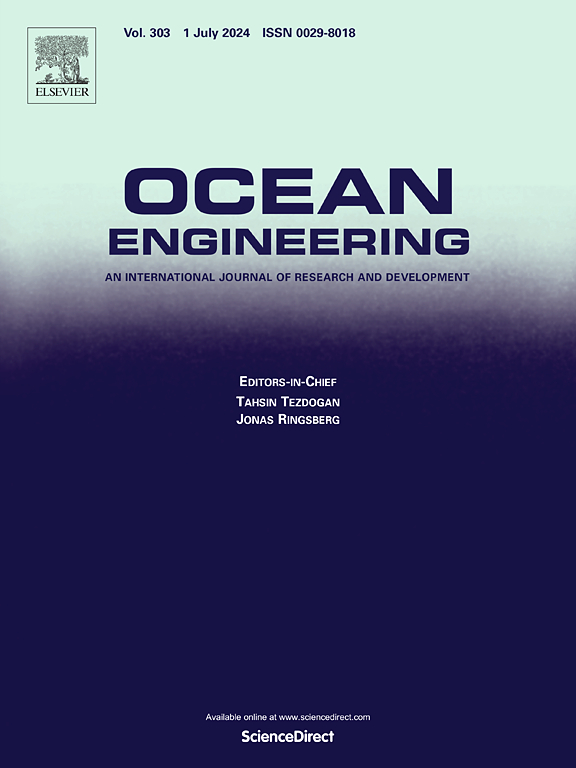Dual-layer dynamic event-triggered formation maneuver control for underactuated autonomous underwater vehicles via edge vector-based method
IF 4.6
2区 工程技术
Q1 ENGINEERING, CIVIL
引用次数: 0
Abstract
This study addresses formation maneuver control for autonomous underwater vehicles (AUVs) under conditions of limited network bandwidth, constrained actuation resources, and multiple uncertainties. Unlike the existing translation and scaling formation control, this study incorporates rotational motion to enable AUVs to navigate curved channels. A leader-first–follower structure is adopted where only the leaders have access to the formation maneuvering parameters. To address these issues, a dual-layer dynamic event-triggered formation maneuver control method is proposed. Specifically, a dynamic event-triggered mechanism (DETM) is employed to save communication resources and a predictor is used to estimate neighbor information during communication intervals. Next, a novel edge vector-based method, which calculates the edge vector between two neighbor positions, is applied to determine the virtual speed for followers. An extended state observer is introduced to estimate the unknown sideslip effect. Subsequently, a dynamic event-triggered control law is developed for AUVs to perform the formation maneuver. This law uses adaptive neural networks to approximate the composite disturbance caused by input constraints, environmental disturbances, and unknown model parameters, while the design DETM avoids unnecessary executions. Eventually, the system stability and the absence of Zeno behavior are demonstrated, and simulation results substantiate the effectiveness of the proposed control scheme.
基于边缘向量的欠驱动自主水下航行器双层动态事件触发编队机动控制
研究了网络带宽有限、驱动资源受限、多不确定性条件下自主水下航行器(auv)编队机动控制问题。与现有的平移和缩放地层控制不同,该研究结合了旋转运动,使auv能够在弯曲的通道中航行。采用leader-first-follower结构,只有leader可以访问编队机动参数。针对这些问题,提出了一种双层动态事件触发编队机动控制方法。具体来说,采用动态事件触发机制(DETM)来节省通信资源,并使用预测器来估计通信间隔内的邻居信息。其次,采用一种新的基于边缘向量的方法,计算两个相邻位置之间的边缘向量,以确定跟随者的虚拟速度。引入扩展状态观测器来估计未知的侧滑效应。在此基础上,提出了一种用于水下机器人编队机动的动态事件触发控制律。该定律使用自适应神经网络来逼近由输入约束、环境干扰和未知模型参数引起的复合干扰,同时设计DETM避免了不必要的执行。最后,证明了系统的稳定性和无芝诺行为,仿真结果证实了所提控制方案的有效性。
本文章由计算机程序翻译,如有差异,请以英文原文为准。
求助全文
约1分钟内获得全文
求助全文
来源期刊

Ocean Engineering
工程技术-工程:大洋
CiteScore
7.30
自引率
34.00%
发文量
2379
审稿时长
8.1 months
期刊介绍:
Ocean Engineering provides a medium for the publication of original research and development work in the field of ocean engineering. Ocean Engineering seeks papers in the following topics.
 求助内容:
求助内容: 应助结果提醒方式:
应助结果提醒方式:


